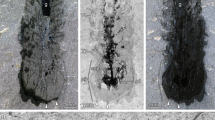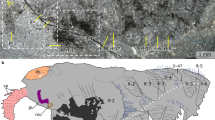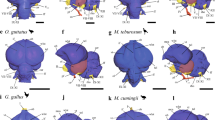Abstract
The nervous system provides a fundamental source of data for understanding the evolutionary relationships between major arthropod groups1,2. Fossil arthropods rarely preserve neural tissue. As a result, inferring sensory and motor attributes of Cambrian taxa has been limited to interpreting external features, such as compound eyes3 or sensilla decorating appendages4, and early-diverging arthropods have scarcely been analysed in the context of nervous system evolution. Here we report exceptional preservation of the brain and optic lobes of a stem-group arthropod from 520 million years ago (Myr ago), Fuxianhuia protensa5, exhibiting the most compelling neuroanatomy known from the Cambrian. The protocerebrum of Fuxianhuia is supplied by optic lobes evidencing traces of three nested optic centres serving forward-viewing eyes. Nerves from uniramous antennae define the deutocerebrum, and a stout pair of more caudal nerves indicates a contiguous tritocerebral component. Fuxianhuia shares a tripartite pre-stomodeal brain and nested optic neuropils with extant Malacostraca and Insecta2,6, demonstrating that these characters were present in some of the earliest derived arthropods. The brain of Fuxianhuia impacts molecular analyses that advocate either a branchiopod-like ancestor of Hexapoda7,8 or remipedes and possibly cephalocarids as sister groups of Hexapoda9,10. Resolving arguments about whether the simple brain of a branchiopod approximates an ancestral insect brain or whether it is the result of secondary simplification has until now been hindered by lack of fossil evidence. The complex brain of Fuxianhuia accords with cladistic analyses on the basis of neural characters, suggesting that Branchiopoda derive from a malacostracan-like ancestor but underwent evolutionary reduction and character reversal of brain centres that are common to hexapods and malacostracans2. The early origin of sophisticated brains provides a probable driver for versatile visual behaviours, a view that accords with compound eyes from the early Cambrian that were, in size and resolution, equal to those of modern insects and malacostracans3.
This is a preview of subscription content, access via your institution
Access options
Subscribe to this journal
Receive 51 print issues and online access
$199.00 per year
only $3.90 per issue
Buy this article
- Purchase on Springer Link
- Instant access to full article PDF
Prices may be subject to local taxes which are calculated during checkout



Similar content being viewed by others
References
Harzsch, S. Neurophylogeny: architecture of the nervous system and a fresh view on arthropod phylogeny. Integr. Comp. Biol. 46, 162–194 (2006)
Strausfeld, N. J. & Andrew, D. R. A new view of insect–crustacean relationships I. Inferences from neural cladistics and comparative neuroanatomy. Arthropod Struct. Dev. 40, 276–288 (2011)
Paterson, J. R. et al. Acute vision in the giant Cambrian predator Anomalocaris and the origin of compound eyes. Nature 480, 237–240 (2011)
Strausfeld, N. J. Some observations on the sensory organization of the crustaceamorph Waptia fieldensis Walcott. Palaeontogr. Canadiana 31, 157–169 (2011)
Chen, J.-Y., Edgecombe, G. D., Ramsköld, L. & Zhou, G.-Q. Head segmentation in early Cambrian Fuxianhuia: implications for arthropod evolution. Science 268, 1339–1342 (1995)
Strausfeld, N. J. Arthropod Brains: Evolution, Functional Elegance, and Historical Significance (Belknap Press, 2012)
Glenner, H., Thomsen, P. F., Hebsgaard, M. B., Sørensen, M. V. & Willerslev, E. The origin of insects. Science 314, 1883–1884 (2006)
Campbell, L. I. et al. MicroRNAs and phylogenomics resolve the relationships of Tardigrada and suggest that velvet worms are the sister group of Arthropoda. Proc. Natl Acad. Sci. USA 108, 15920–15924 (2011)
von Reumont, B. M. et al. Pancrustacean phylogeny in the light of new phylogenomic data: support for Remipedia as the possible sister group of Hexapoda. Mol. Biol. Evol. 29, 1031–1045 (2012)
Regier, J. C. et al. Arthropod relationships revealed by phylogenomic analysis of nuclear protein-coding sequences. Nature 463, 1079–1083 (2010)
Hou, X.-G. et al. The Cambrian Fossils of Chengjiang, China: The Flowering of Early Animal Life (Blackwell, 2004)
Bergström, J., Hou, X.-G., Zhang, X.-G. & Clausen, S. A new view of the Cambrian arthropod Fuxianhuia. GFF 130, 189–201 (2008)
Budd, G. E. Head structure in upper stem-group euarthropods. Palaeontology 51, 561–573 (2008)
Waloszek, D., Chen, J.-Y., Haas, A. & Wang, X.-Q. Early Cambrian arthropods – new insights into arthropod head and structural evolution. Arthropod Struct. Dev. 31, 189–205 (2005)
Gaines, R. R. et al. Mechanism for Burgess Shale-type preservation. Proc. Natl Acad. Sci. USA 109, 5180–5184 (2012)
Hou, X.-G., Ma, X.-Y., Zhao, J. & Bergstrom, J. The lobopodian Paucipodia inermis from the lower Cambrian Chengjiang fauna, Yunnan, China. Lethaia 37, 234–244 (2004)
Land, M. F. in Facets of Vision 90–111 (Springer, 1989)
Sandeman, D. C. & Scholtz, G. in The Nervous Systems of Invertebrates: An Evolutionary and Comparative Approach 329–347 (Birkhäuser, 1995)
Sombke, A. et al. Comparative analysis of deutocerebral neuropils in Chilopoda (Myriapoda): implications for the evolution of the arthropod olfactory system and support for the Mandibulata concept. BMC Neurosci. 13, 1–17 (2012)
Boyan, G. S., Williams, J. L. D. & Hirth, F. in Evolution of Nervous Systems I 249–360 (Academic Press, 2006)
Kirsch, R. & Richter, S. The nervous system of Leptodora kindtii (Branchiopoda, Cladocera) surveyed with confocal scanning microscopy (CLSM), including general remarks on the branchiopod neuromorphological ground pattern. Arthropod Struct. Dev. 36, 143–156 (2007)
Elofsson, R. & Dahl, E. The optic neuropils and chiasmata of Crustacea. Z. Zellforsch. Mikrosk. Anat. 107, 343–360 (1970)
Strausfeld, N. J. The evolution of crustacean and insect optic lobes and the origin of chiasmata. Arthropod Struct. Dev. 34, 235–256 (2005)
Sinakevitch, I., Douglass, J. K., Scholtz, G., Loesel, R. & Strausfeld, N. J. Conserved and convergent organization in the optic lobes of insects and isopods, with reference to other crustacean taxa. J. Comp. Neurol. 467, 150–172 (2003)
Wolff, G., Harzsch, S., Hansson, B. S., Brown, S. & Strausfeld, N. Neuronal organization of the hemiellipsoid body of the land hermit crab Coenobita clypeatus: correspondence with the mushroom body ground pattern. J. Comp. Neurol. 520, 2824–2846 (2012)
Fanenbruck, M. & Harzsch, S. A brain atlas of Godzilliognomus frondosus Yager, 1989 (Remipedia, Godzilliidae) and comparison with the brain of Speleonectes tulumensis Yager, 1987 (Remipedia, Speleonectidae): implications for arthropod relationships. Arthropod Struct. Dev. 34, 343–378 (2005)
Andrew, D. R., Brown, S. M. & Strausfeld, N. J. The minute brain of the copepod Tigriopus californicus supports a complex ancestral ground pattern of the tetraconate cerebral nervous systems. J. Comp. Neurol. 520, 3446–3470 (2012)
Stegner, M. E. & Richter, S. Morphology of the brain in Hutchinsoniella macracantha (Cephalocarida, Crustacea). Arthropod Struct. Dev. 40, 221–243 (2011)
Hanström, B. Eine genetische Studie über die Augen und Sehzentren von Turbellarien, Anneliden und Arthropoden (Trilobiten, Xiphosuren, Eurypteriden, Arachnoiden, Myriapoden, Crustaceen und Insekten). Kungl. Svensk. Vetenskapsakad. Handl. 4, 1–176 (1926)
Dohle, W. Are the insects terrestrial crustaceans? A discussion of some new facts and arguments and the proposal of the proper name ‘Tetraconata’ for the monophyletic unit Crustacea + Hexapoda. Ann. Soc. Entomol. Fr. 37, 85–103 (2001)
Acknowledgements
This account is dedicated to J. Bergström, who was first in suggesting a brain in YKLP 15006. The present work was supported by the National Natural Science Foundation of China (40730211), a Leverhulme Trust Research Project Grant (F/00 696/T), and the Center for Insect Science, University of Arizona. We thank A. Ball and J. Spratt for their assistance with scanning electron microscopy imagery and energy-dispersive X-ray spectroscopy, respectively.
Author information
Authors and Affiliations
Contributions
All authors contributed equally to this work.
Corresponding author
Ethics declarations
Competing interests
The authors declare no competing financial interests.
Supplementary information
Supplementary Figures
This file contains Supplementary Figures 1-4. (PDF 672 kb)
Rights and permissions
About this article
Cite this article
Ma, X., Hou, X., Edgecombe, G. et al. Complex brain and optic lobes in an early Cambrian arthropod. Nature 490, 258–261 (2012). https://doi.org/10.1038/nature11495
Received:
Accepted:
Published:
Issue Date:
DOI: https://doi.org/10.1038/nature11495
This article is cited by
-
Exceptional fossil preservation and evolution of the ray-finned fish brain
Nature (2023)
-
Unparalleled details of soft tissues in a Cretaceous ant
BMC Ecology and Evolution (2022)
-
The visual pathway in sea spiders (Pycnogonida) displays a simple serial layout with similarities to the median eye pathway in horseshoe crabs
BMC Biology (2022)
-
Neuroanatomy in a middle Cambrian mollisoniid and the ancestral nervous system organization of chelicerates
Nature Communications (2022)
-
Ordovician opabiniid-like animals and the role of the proboscis in euarthropod head evolution
Nature Communications (2022)
Comments
By submitting a comment you agree to abide by our Terms and Community Guidelines. If you find something abusive or that does not comply with our terms or guidelines please flag it as inappropriate.



